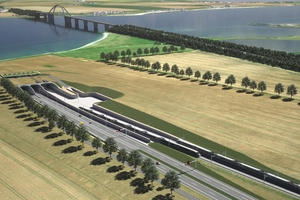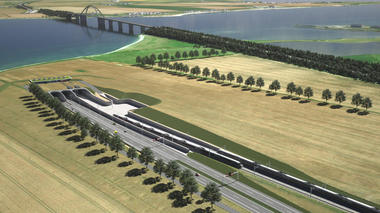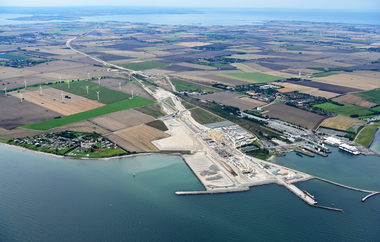Decision on the New Fehmarn Sound Crossing: Constructionof an Immersed Tunnel and Preservation of the Bridge
In March 2020, a solution for the new crossing of the Fehmarn Sound (Fehmarnsund) was found; the German Federal Ministry of Transport, the state of Schleswig-Holstein and Deutsche Bahn compared all the options and decided on an immersed tunnel for road and rail. The Fehmarnsund Bridge will be retained for pedestrians, cyclists and slow road traffic.
Parliamentary State Secretary Enak Ferlemann: “In a comprehensive comparison of the conceivable variants, the immersed tunnel also proved to be the superior variant in the sensitivity analyses“. He is particularly pleased that this solution also takes into account the wishes of the region to preserve the old Fehmarnsund Bridge as a landscape-forming structure.
Connection of the Danish Fehmarn Belt Fixed Link to the German Rail and Road Network
As part of the connection of the Danish Fehmarn Belt Fixed Link to the German rail and road network, a replacement structure is required for the existing Fehmarn Sound crossing between the island of Fehmarn and the mainland of eastern Holstein. The bridge built in 1963 is not able to cope with the future loads of road and rail traffic.
For this reason, numerous variants (bored and immersed tunnels as well as combined and separate bridges) for a more efficient crossing were investigated in a complex procedure. This procedure has been completed with the decision that has now been made.
The tunnel solution for maintaining the Fehmarnsund Bridge takes into account the traffic requirements and also corresponds to the consensus variant worked out by the “Dialogue Forum Fixed Fehmarn Belt Crossing” within the framework of public participation, which includes the preservation of the old Fehmarnsund Bridge.
1.7 km Long Immersed Tunnel for Road
and Rail Traffic
The new 1.7 km-long immersed tunnel will have two double-track tubes for road traffic and two single-track tubes for rail. It is scheduled to be completed in time for the opening of the fixed link across the Fehmarn Belt. The existing Fehmarnsund Bridge will be upgraded and used for slow traffic, cyclists and pedestrians.
The construction costs for the immersed tunnel amount to 714 million euros. This includes both rail and road components. It is scheduled to be commissioned in 2028 together with the Danish tunnel.
M. K./G. B.






